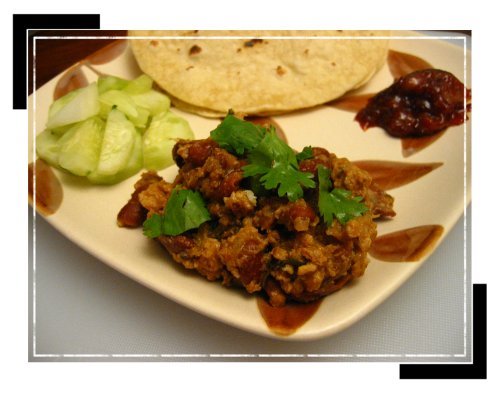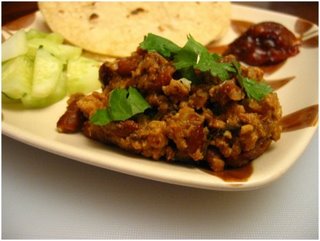That means Green JackFruit Curry
Enchor (ch pronounced as in chair and not as in choir) or Green Jackfruit is another veggie pretty popular in Bengal. I knew the jackfruit tree grows in the tropics but didn’t know this:
The jackfruit is believed indigenous to the rain forests of the Western Ghats of India. It spread early on to other parts of India, southeast Asia, the East Indies and ultimately the Philippines. It is often planted in central and eastern Africa and is fairly popular in Brazil and Surinam.
The jackfruit is believed indigenous to the rain forests of the Western Ghats of India. It spread early on to other parts of India, southeast Asia, the East Indies and ultimately the Philippines. It is often planted in central and eastern Africa and is fairly popular in Brazil and Surinam.
Both the ripenend fruit of this tree, popularly known as Kathal in Bengali & Hindi and the green unripe one known as Enchor in Bengali is very popular. The ripened jackfruit is sweet and has a delicious heady smell and is eaten as a fruit. The green unripe one is eaten as a vegetable. It is also a very nutritious fruit. It contains protein, fat, calcium, iron vitamin B, B2 and vitamin A. More on JackFruit here.
My grandparents house in Bihar had a huge jackfruit tree in the garden and it produced abundant fruits during summer. The huge tree with broad, deep green glossy leaves & the green jackfruits clinging to it was a pleasure to watch. Though I was not very fond of the ripened jackfruit I liked the enchor er dalna or the green jackfruit curry. The enchor when cooked in the aamish or non-veg way with onion & garlic closely resembles the goat meat and hence this enchor also has a nickname in Bengal “Gach Pa(n)tha” which literally translated means “Tree Goat” but the essence being Vegetarian Meat.
Also if you are a young Bong and are trying to act too smart, you know what the elders would say, you are “Enchore Paka” !!!! This means you are a green jackfruit who has ripened before age ;-)
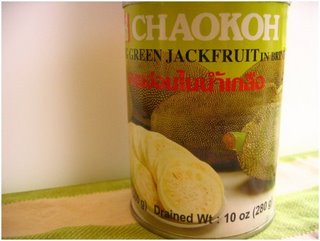
Here in the US I like the Chaokoh canned green Jackfruit. They are pretty tender and since they are canned in brine, it takes very little time to cook
I cooked jackfruit in the non-vegetarian way with onion & garlic over the weekend. I also threw in some shrimp after I saw that a dish called Enchor Chingri really exists, I can go that extra mile for my love of shrimp. You can skip the shrimp, no harm done, my Ma never cooked enchor with shrimp.
What You Need
1 can of Chaokoh Green JackFruit ~ 1 can is about 570g. I got it from my Indian Grocery Store, you can try other Asian stores too. It is here on Amazon, but the price of the same can is 3 times as compared to my local store!!!
Potatoes ~ 1 whole, peeled and cut in cubes
Onions ~ 1 medium grind to a paste
Tomatoes ~ 1 medium very well chopped
Green Chillies ~ 3/4 chopped (Optional)
1 can of Chaokoh Green JackFruit ~ 1 can is about 570g. I got it from my Indian Grocery Store, you can try other Asian stores too. It is here on Amazon, but the price of the same can is 3 times as compared to my local store!!!
Potatoes ~ 1 whole, peeled and cut in cubes
Onions ~ 1 medium grind to a paste
Tomatoes ~ 1 medium very well chopped
Green Chillies ~ 3/4 chopped (Optional)
For Phoron or tempering:
TejPata or BayLeaves ~ 3 or 4
Dry red Chillies ~ 3/4
For Masala:
Elaichi / Cardamom ~ 2-3
Darchini or Cinnamon ~ a small stick
Laung or Cloves ~ 2-3
Jeera or Cumin Powder ~ about 2 tsp
Garlic Paste ~ 1 tsp
Ginger Paste ~ 1 tsp
Yogurt ~ 1 tbsp
Turmeric Powder
Garam Masala Powder ~ 1/2 tsp
Ghee ~ 1 tsp optional
Salt
With Shrimp:
15/20 pre cooked medium or small shrimp ~ after thawing mix them with little turmeric powder and salt.
How I Do It
Since the jackfruit is canned in brine, it becomes a little salty. So the night before you cook, open the can, drain the liquid, wash the jackfruit several times in water and soak them in fresh water over night
Cut the Jackfruit pieces in Cubes, cut Potatoes in Cubes
Note: Toss the jackfruit cubes with a little Red Chili powder, 1/2 tsp of Cumin and Corriander powder each
Heat Oil in Kadai/Frying Pan
If I am using shrimp I fry the shrimp first and then keep them aside
Note: Add about 1/2 tsp of sugar to the oil if using canned jackfruit. When the sugar browns add the jackfruit pieces. Lightly fry the jackfruit pieces in oil. Remove and keep aside. Similarly saute the potatoes. Remove and keep aside.
Add the Tej Pata (Bay Leaves) and Dry Red Chillies as phoron
Coarsely pound the Elaichi (Cardamom), Laung (Cloves) & Darchini (Cinnamon Sticks) and add it to the oil
As soon as the spices start crackling Add the onions.
Add a little sugar and fry them till they are light brown in color.
Note: You can also chop onion in large chunks --> fry till soft and brown on the edges --> cool and blend. Use this fried onion paste instead of raw onion paste for a very nice taste.
Add the chopped tomato and the green chillies
Continue frying till the tomatoes are well blended, all mushed up.
Since the jackfruit is canned in brine, it becomes a little salty. So the night before you cook, open the can, drain the liquid, wash the jackfruit several times in water and soak them in fresh water over night
Cut the Jackfruit pieces in Cubes, cut Potatoes in Cubes
Note: Toss the jackfruit cubes with a little Red Chili powder, 1/2 tsp of Cumin and Corriander powder each
Heat Oil in Kadai/Frying Pan
If I am using shrimp I fry the shrimp first and then keep them aside
Note: Add about 1/2 tsp of sugar to the oil if using canned jackfruit. When the sugar browns add the jackfruit pieces. Lightly fry the jackfruit pieces in oil. Remove and keep aside. Similarly saute the potatoes. Remove and keep aside.
Add the Tej Pata (Bay Leaves) and Dry Red Chillies as phoron
Coarsely pound the Elaichi (Cardamom), Laung (Cloves) & Darchini (Cinnamon Sticks) and add it to the oil
As soon as the spices start crackling Add the onions.
Add a little sugar and fry them till they are light brown in color.
Note: You can also chop onion in large chunks --> fry till soft and brown on the edges --> cool and blend. Use this fried onion paste instead of raw onion paste for a very nice taste.
Add the chopped tomato and the green chillies
Continue frying till the tomatoes are well blended, all mushed up.
Note: For a smoother curry, puree the tomatoes and green chili and then cook
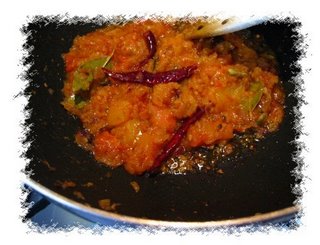
Add the potatoes, a pinch of turmeric powder and fry till they take on a light golden hue
Add 1 tsp of Ginger Paste & 1 tsp of Garlic Paste
Add about 2 tsp of jeera Powder mixed in 1 tbsp of Yogurt to a paste and continue what we say in Bangla as “Kashano”. I don’t know how to explain this but this means cook, stir do the whole routine, till the masala looks and feels cooked.
Note: Instead of only Cumin Powder, you can add 1 tsp Roasted Cumin Powder + 1 tsp Roasted Corriander powder + 1/2 tsp of Kashmiri Mirch. I normally lightly dry roast cumin & corriander and then make a large batch of such powder.
Add the cubed green jackfruit and Cook for some more time till the masala coats the jackfruit and the potatoes nicely.

Add little water as needed for gravy, salt, and cover and Cook
Cook till Potatoes and Enchor or jackfruit is done.
Note: Adjust for salt and seasonings. I usually add some sugar at this point to balance the tartness of canned jackfruit
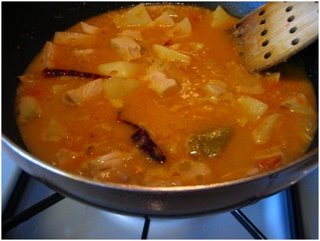
The above pic is before the potatoes were done, so the gravy reduces more and the gravy is not very watery
If I am adding shrimp, I add the fried shrimps at this point
Sprinkle a little Garam Masala Powder and add a ½ tsp of ghee (optional , but lends a nice smell)
Cook for maybe some more minutes, check if tastes perfect and you are done.
Have this with Rice or Roti.
For the Vegetarian or Niramish way:
I asked my Ma for this and though I haven’t tried this, this is how she makes it.
Heat Oil and add about 1 heaped tbsp of Ginger paste and about ½ tsp of hing or asafoetida powder.
Saute and add BayLeaves , Dry Red Chillies and coarsely ground Elaichi, Cardamom, & Darchini
Follow procedures as above, but omit the onions & garlic Paste.
Also along with Cumin Powder add Corriander Powder.
Rest is same.
Everyone at home enjoyed this dalna and even my almost 3 yr old who is not a veggie fan ate up her enchor.
This is my entry for WHB a event started by Kalyn of Kalyn's Kitchen and this week hosted by Nandita of Saffron Trail. I was not sure if I could send an entry for this but since I cooked this over the weekend, I thought it would be a nice thing to share.
Trivia: Jackfruit or Kathal is the National fruit of Bangladesh. Wow that's a big thing



